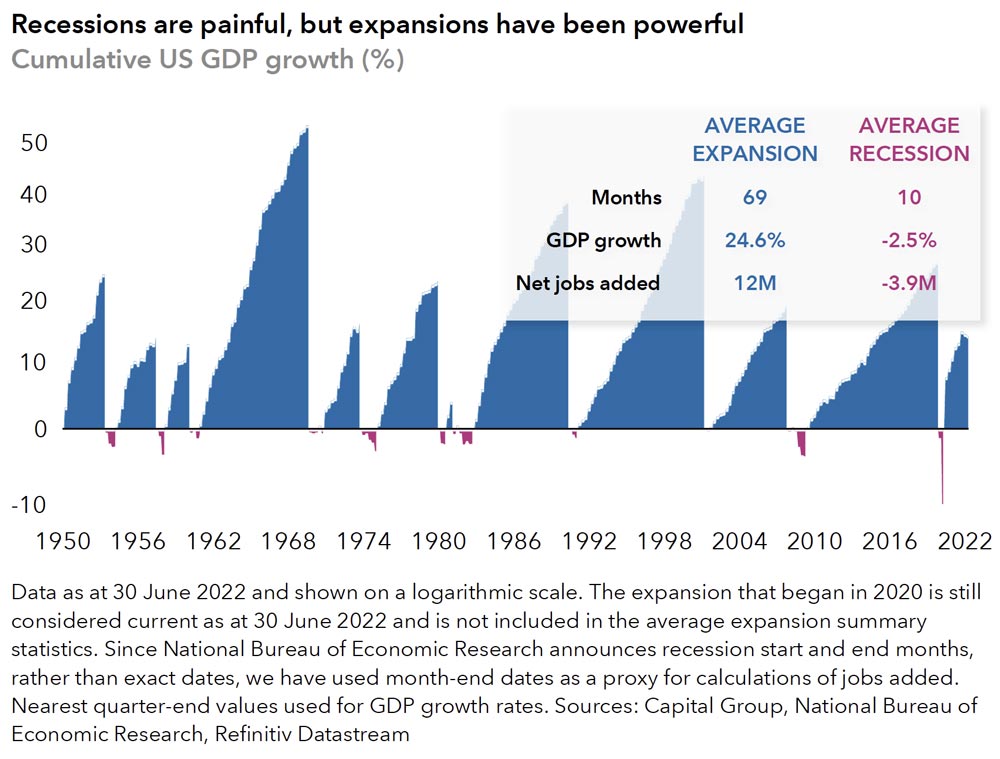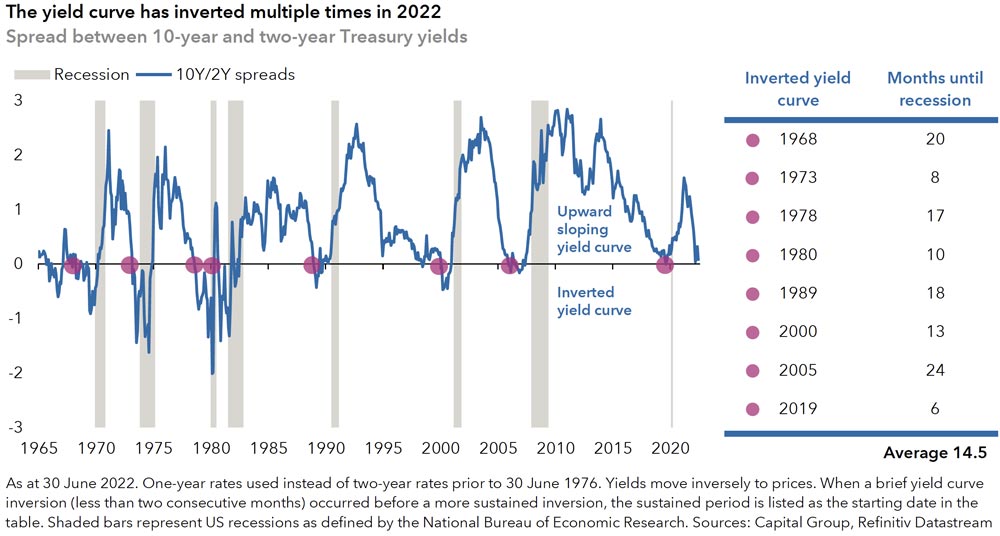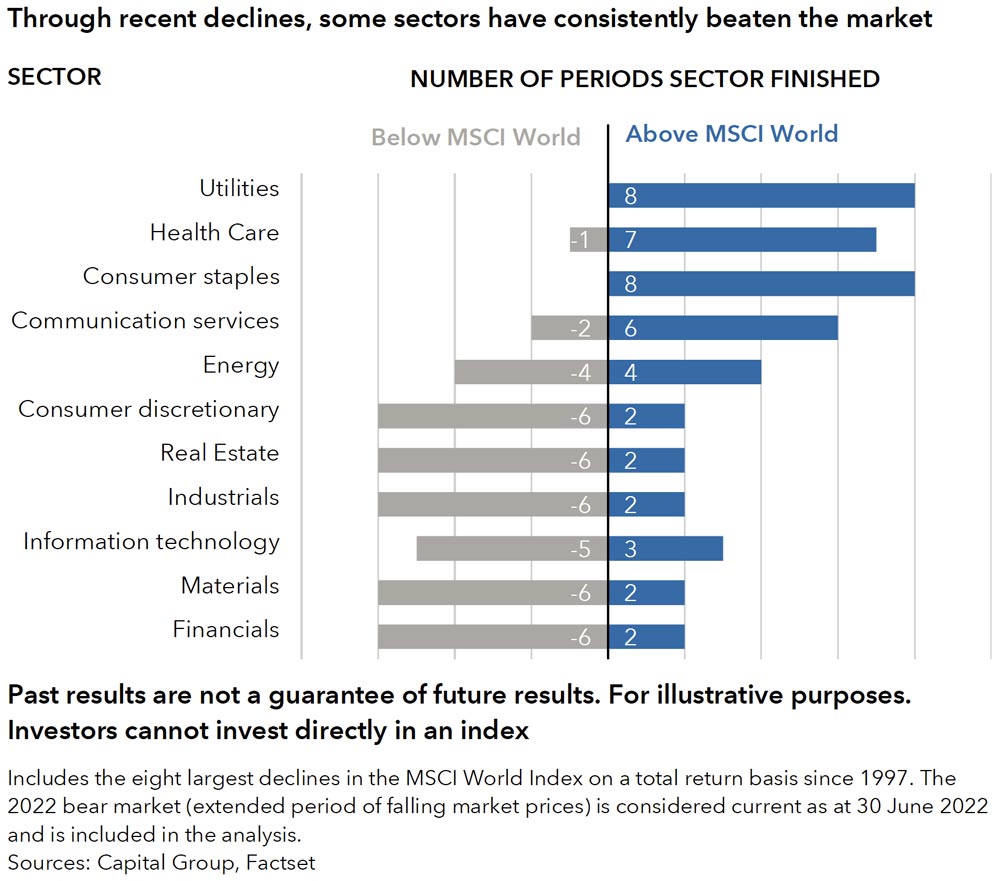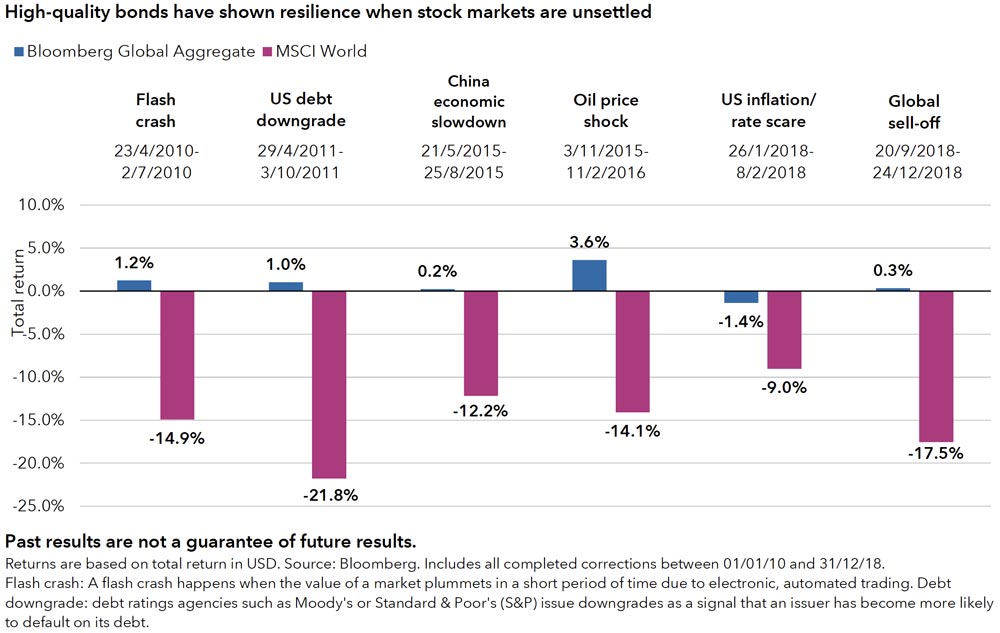By Jared Franz and Darrell Spence, Economists at Capital Group
Key takeaways
• Recessions are a necessary part of every business cycle, are infrequent, and tend to be small blips in economic history.
• An inverted yield curve in the US has been among the more reliable recession indicators over the last 50 years, typically following one year to 18 months after.
• Bear markets often coincide with recessions, but equity returns can often be positive over the full length of an economic contraction. Sectors including utilities and consumer staples have held up better during slowdowns.
• Fixed income could be integral to successful investing during a recession, potentially offering stability and capital preservation.
• Global recession appears unlikely until later this year or early 2023. The exact timing will likely depend on the pace and magnitude of central bank moves as they attempt to bring inflation back to target levels.
Recession risk is clearly elevated around the world following the COVID pandemic and Russia’s invasion of Ukraine, especially as central banks are forced to hike interest rates as they try to control spiralling inflation.
While investors are understandably asking when the next economic downturn might hit, history indicates that recessions are notoriously hard to forecast with any accuracy and even the term itself is subject to debate. For reference, the US National Bureau of Economic Research classifies recession as ‘a significant decline in economic activity spread across the economy, lasting more than a few months, normally visible in real [inflation-adjusted] gross domestic product (GDP), real income, employment, industrial production and wholesale-retail sales.’
One commonly cited definition is two consecutive quarters of negative GDP and by that measure, the US is already in recession. On the other hand, however, consistently strong job growth, historically low unemployment and solid growth in consumer spending would appear to argue against that.
Rather than attempting to forecast exactly when global markets might fall into actual recession this time, this paper examines what economic indicators are worth monitoring to signal slowing conditions, how equities have fared in previous downturns, and, most importantly, what investors might consider doing to prepare.
What causes recessions and how long do they last?
First, it is important to stress that recessions are a natural and necessary part of every business cycle. Past recessions have occurred for a variety of reasons, but they are typically the result of imbalances that build up in the economy and ultimately need to be corrected before the next expansion can begin.
Looking at recent examples, the 2008 recession was primarily caused by excess debt in the housing market, for example, while the 2001 contraction had its roots in the rapid rise and fall in technology stocks. In the latest instance, many would point to loose monetary and fiscal policy¹ in place since the Global Financial Crisis, obviously exacerbated by recent geopolitical and epidemiological events.
Although historical trends are not a guide to future ones, data shows that recessions tend not to last very long. Our analysis of 11 business cycles in the US since 1950 shows recessions have ranged from just two to 18 months, with the average lasting about 10. Moreover, the overall economic impact of most recessions is also relatively limited: the average expansion has increased economic output by close to 25%, whereas the average recession only reduced it by 2.5%².
For anyone directly affected by job loss or business closures, 10 months of recession can clearly feel like a long time. But investors with a long-term investment horizon might consider looking at the full picture: over the last 70 years, the US market has been in official recession less than 15% of the time².

Despite the pain they cause, recessions are relatively small blips in economic history and equity returns can even be positive over the full length of a contraction, with some of the strongest rallies occurring during the late stages of a recession. Equities typically peak around seven months before recession starts but can bounce back quickly. Aggressive moves into cash or other assets therefore have the potential to backfire and, in some circumstances, it might be better to stay invested to avoid missing out on the eventual upswing.
This is exactly why many seasoned market watchers prefer an averaging strategy, where they invest equal amounts at regular intervals whatever the conditions. This approach not only allows investors to buy more shares at lower prices but also positions them to benefit when the market eventually rebounds. That said, averaging strategies do not ensure profits or protect against losses and investors should consider their capacity to keep committing capital to markets while prices are falling.
Economic indicators to watch: the 2s10s yield curve
While it is hard to forecast recessions accurately, there are some generally reliable economic signs worth watching closely as economies reach the latter stages of a cycle. Standard measures such as rising unemployment and falling consumer confidence, and activity from housebuilders, give some indication a slowdown may be on the way but a more interesting – and traditionally more accurate – measure has been the so-called 2s10s yield curve in the US.
Put simply, this shows the relationship between 10-year and two-year US government bonds (Treasuries). The yields on the former are usually higher, with investors wanting a higher return for lending their capital for longer. When this relationship inverts (creating what is called an inverted yield curve, where two-year yields are higher than 10-year yields), recession has typically followed a year to 18 months after (14.5 months on average).

Notably, this market signal has presaged each US slowdown since the 1970s, although there are other factors to keep in mind. Before this year, the last time the 2s10s curve inverted was in September 2019 and, quicker than usual, the economy was in recession just six months later. Of course, the world was also right in the initial eye of the COVID storm at that point, which clearly had a huge impact on economies all around the world.
There is debate over whether central bank interventions in the bond market over recent years have distorted the yield curve to the point where it may be a less reliable indicator, but that remains to be seen.
Short-term Treasury rates typically rise (and prices fall) during periods where the US Federal Reserve (Fed) is tightening policy by raising interest rates, while long-term Treasury rates usually fall when demand for bonds is rising. An inverted curve is seen as a sign investors are becoming more nervous, because it indicates they are moving to the perceived safe haven of long-term government bonds rather than buying riskier assets.
Over recent months, we saw the 2s10 curve invert briefly in April and again in June before dropping to new lows in July and – importantly – remaining inverted for a prolonged period. It would not be surprising if this persists as the Fed continues to raise rates, and the economic outlook carries on deteriorating.
Investment considerations during tougher times
As outlined earlier, trying to time the market is often ill advised, particularly during volatile periods, but that does not necessarily imply that investors should do nothing. While goals vary by individual, as a first step, investors with equity and bond holdings might take the opportunity to review their overall asset allocation, which may have changed significantly during recent strong periods of equity market returns, and assess whether their portfolio is still broadly diversified.
From an equity perspective, not all sectors respond the same during periods of economic stress. Looking at the eight largest equity market declines, using the MSCI World Index between 1997 and 2022, some sectors have held up more consistently than others. Consumer staples and utilities, for example, outperformed the index in all eight of these periods. Adding in healthcare as well, which outperformed in seven of the eight, companies in these sectors often pay out meaningful dividends, which can offer more stable return potential when stock prices are broadly declining.

With tougher times expected, investors may wish to consider companies with strong balance sheets, consistent cash flows and longer-term growth prospects as a possible route to withstanding short-term market fluctuations.
Meanwhile, fixed income can often prove integral to successful investing during a recession or bear market, offering essential stability and the potential for capital preservation. The market sell-off in the first half of 2022 was unusual in that bonds did not play their perceived safe-haven role – with inflation and interest rates rising, fixed income markets fell alongside equity markets and diversification benefits broke down.
In the six previous equity market corrections between 2010 and 2018, however, global bond markets – as measured by the Bloomberg Global Aggregate Index – were able to post positive returns in all but one. Even during the broad sell-off in January/February 2018, as markets reacted badly to concerns over US inflation and possible interest rate rises, global bonds were only down 1.4% versus 9.0% from the MSCI World Index.

Investors do not necessarily need to consider increasing their bond exposure ahead of any forthcoming recession, but it is worth them assessing whether their overall asset allocation mix provides elements of the four roles that fixed income might fulfil: diversification from equities, income, capital preservation and inflation protection.
Where are we now?
While signs of an economic slowdown are already evident in some parts of the world, our view is that recession still appears unlikely until later in 2022 or early 2023. In the US, high inflation has had a major impact on consumer sentiment and corporate earnings, but a strong labour market continues to support the economy in the near term. Conditions are obviously different around the world, with the UK struggling with a cost-of-living crisis, while Europe is far more exposed to energy supply risk due to its reliance on Russian oil.
The exact timing of a recession will likely depend on the pace and magnitude of central bank moves as they attempt to bring inflation back to target levels. In our view, the only way to break the spiral of escalating wages and prices – particularly in the US – is to create slack in the labour market (the shortfall between the volume of work desired by workers and the actual volume available). But given disruptions caused by the pandemic, unemployment may have to climb as high as 5% or 6% before wage growth starts to moderate. We believe this will make recession very hard to avoid by 2023.
Further geopolitical shocks – such as escalation of the war in Ukraine or new variants of the COVID pandemic – are even harder to predict and could quicken the timeline.
Footnotes:
¹ Fiscal policy is the use of government spending and taxation to influence the economy. Monetary policy is the action a central bank or a government can take to influence how much money is in a country’s economy and how much it costs to borrow.
² Data as at 30 June 2022. Sources: Capital Group, National Bureau of Economic Research, Refinitiv Datastream
Disclaimers:
Statements attributed to an individual represent the opinions of that individual as of the date published and may not necessarily reflect the view of Capital Group or its affiliates.
Risk factors you should consider before investing:
• This material is not intended to provide investment advice or be considered a personal recommendation.
• The value of investments and income from them can go down as well as up and you may lose some or all of your initial investment.
• Past results are not a guide to future results.
• If the currency in which you invest strengthens against the currency in which the underlying investments of the fund are made, the value of your investment will decrease. Currency hedging seeks to limit this, but there is no guarantee that hedging will be totally successful.
• Risks may be associated with investing in fixed income, emerging markets and/or high-yield securities; emerging markets are volatile and may suffer from liquidity problems.tat
While Capital Group uses reasonable efforts to obtain information from third-party sources which it believes to be reliable, Capital Group makes no representation or warranty as to the accuracy, reliability or completeness of the information. The material is of a general nature, and not intended to provide investment, tax or other advice, or to be a solicitation to buy or sell any securities. It does not take into account your objectives, financial situation or needs. Before acting on the information you should consider its appropriateness, having regard to your own investment objectives, financial situation and needs.
This communication is issued by Capital International Management Company Sàrl (“CIMC”), 37A avenue J.F. Kennedy, L-1855 Luxembourg, unless otherwise specified, and is distributed for information purposes only. CIMC is regulated by the Commission de Surveillance du Secteur Financier (“CSSF” – Financial Regulator of Luxembourg) and is a subsidiary of the Capital Group Companies, Inc. (Capital Group).
In the UK, this communication is issued by Capital International Limited (authorised and regulated by the UK Financial Conduct Authority), a subsidiary of the Capital Group Companies, Inc. (Capital Group).
In Switzerland, this communication is issued by Capital International Sàrl (authorised and regulated by the Swiss Financial Market Supervisory Authority (FINMA)), a subsidiary of the Capital Group Companies, Inc.
In Hong Kong, this communication has been prepared by Capital International, Inc., a member of Capital Group, a company incorporated in California, United States of America. The liability of members is limited. In Singapore, this communication has been prepared by Capital Group Investment Management Pte. Ltd., a member of Capital Group, a company incorporated in Singapore. This advertisement or publication has not been reviewed by the Monetary Authority of Singapore. Neither has it been reviewed by any other regulator.
In Australia, this communication is issued by Capital Group Investment Management Limited (ACN 164 174 501 AFSL No. 443 118), a member of Capital Group, located at Level 18, 56 Pitt Street, Sydney NSW 2000 Australia.
All Capital Group trademarks are owned by The Capital Group Companies, Inc. or an affiliated company in the US, Australia and other countries. All other company and product names mentioned are the trademarks or registered trademarks of their respective companies.
© 2022 Capital Group. All rights reserved. CR-424341 EAAU




